Patterned Metal/Polymer Composite Film with Good Mechanical Stability and Repeatability for Flexible Electronic Devices Using Nanoimprint Technology
Abstract
:1. Introduction
2. Experimental Section
2.1. Fabrication of Metal/Polymer Composite Films
2.2. Surface Characterization
2.3. Adhesion Testing
3. Results and Discussion
3.1. Morphology of Ag/Polydimethylsiloxane (PDMS) Composite Films
3.2. Tensile Property
3.3. Bending Property
3.4. Interfacial Adhesion Property
4. Conclusions
Author Contributions
Funding
Conflicts of Interest
References
- Atalay, O.; Atalay, A.; Gafford, J.; Wang, H.; Wood, R.; Walsh, C. A highly stretchable capacitive-based strain sensor based on metal deposition and laser rastering. Adv. Mater. Technol. 2017, 2, 1700081. [Google Scholar] [CrossRef]
- Lu, L.; Wei, X.; Zhang, Y.; Zheng, G.; Dai, K.; Liu, C.; Shen, C. A flexible and self-formed sandwich structure strain sensor based on AgNW decorated electrospun fibrous mats with excellent sensing capability and good oxidation inhibition properties. J. Mater. Chem. C 2017, 5, 7035–7042. [Google Scholar] [CrossRef]
- Luan, J.; Wang, Q.; Zheng, X.; Li, Y.; Wang, N. Flexible metal/polymer composite films embedded with silver nanowires as a stretchable and conductive strain sensor for human motion monitoring. Micromachines 2019, 10, 372. [Google Scholar] [CrossRef] [PubMed]
- Cho, J.H.; Ha, S.H.; Kim, J.M. Transparent and stretchable strain sensors based on metal nanowire microgrids for human motion monitoring. Nanotechnology 2018, 29, 155501. [Google Scholar] [CrossRef] [PubMed]
- Kook, G.; Jeong, S.; Kim, S.H.; Kim, M.K.; Lee, S.; Cho, I.J.; Choi, N.; Lee, H.J. Wafer-scale multilayer fabrication for silk fibroin-based microelectronics. ACS Appl. Mater. Interfaces 2019, 11, 115–124. [Google Scholar] [CrossRef] [PubMed]
- Jia, L.C.; Yan, D.X.; Liu, X.; Ma, R.; Wu, H.Y.; Li, Z.M. Highly efficient and reliable transparent electromagnetic interference shielding film. ACS Appl. Mater. Interfaces 2018, 10, 11941–11949. [Google Scholar] [CrossRef] [PubMed]
- Liu, R.; Tan, M.; Zhang, X.; Xu, L.; Chen, J.; Chen, Y.; Tang, X.; Wan, L. Solution-processed composite electrodes composed of silver nanowires and aluminum-doped zinc oxide nanoparticles for thin-film solar cells applications. Sol. Energ. Mat. Sol. C. 2018, 174, 584–592. [Google Scholar] [CrossRef]
- Wang, C.; Zhao, J.; Ma, C.; Sun, J.; Tian, L.; Li, X.; Li, F.; Han, X.; Liu, C.; Shen, C.; et al. Detection of non-joint areas tiny strain and anti-interference voice recognition by micro-cracked metal thin film. Nano Energy 2017, 34, 578–585. [Google Scholar] [CrossRef]
- Nur, R.; Matsuhisa, N.; Jiang, Z.; Nayeem, M.O.G.; Yokota, T.; Someya, T. A highly sensitive capacitive-type strain sensor using wrinkled ultrathin gold films. Nano Lett. 2018, 18, 5610–5617. [Google Scholar] [CrossRef]
- Huang, W.; Li, J.; Zhao, S.; Han, F.; Zhang, G.; Sun, R.; Wong, C.-P. Highly electrically conductive and stretchable copper nanowires-based composite for flexible and printable electronics. Compos. Sci. Technol. 2017, 146, 169–176. [Google Scholar] [CrossRef]
- Wei, Y.; Chen, S.; Lin, Y.; Yuan, X.; Liu, L. Silver nanowires coated on cotton for flexible pressure sensors. J. Mater. Chem. C 2016, 4, 935–943. [Google Scholar] [CrossRef]
- Karim, N.; Afroj, S.; Tan, S.; He, P.; Fernando, A.; Carr, C.; Novoselov, K.S. Scalable production of graphene-based wearable e-textiles. ACS Nano 2017, 11, 12266–12275. [Google Scholar] [CrossRef] [PubMed]
- Park, H.; Kim, J.W.; Hong, S.Y.; Lee, G.; Kim, D.S.; Oh, J.h.; Jin, S.W.; Jeong, Y.R.; Oh, S.Y.; Yun, J.Y.; et al. Microporous polypyrrole-coated graphene foam for high-performance multifunctional sensors and flexible supercapacitors. Adv. Funct. Mater. 2018, 28, 1707013. [Google Scholar] [CrossRef]
- Lee, E.; Kim, T.; Suh, H.; Kim, M.; Pikhitsa, P.V.; Han, S.; Koh, J.S.; Kang, D. Effect of metal thickness on the sensitivity of crack-based sensors. Sensors 2018, 18, 2872. [Google Scholar] [CrossRef] [PubMed]
- Ibru, T.; Kalaitzidou, K.; Baldwin, J.K.; Antoniou, A. Stress-induced surface instabilities and defects in thin films sputter deposited on compliant substrates. Soft Matter. 2017, 13, 4035–4046. [Google Scholar] [CrossRef] [PubMed]
- Lee, I.; Kim, S.; Yun, J.; Park, I.; Kim, T.S. Interfacial toughening of solution processed Ag nanoparticle thin films by organic residuals. Nanotechnology 2012, 23, 485704. [Google Scholar] [CrossRef] [PubMed] [Green Version]
- Zhang, X.; Mu, Y.; Dodaran, M.; Shao, S.; Moldovan, D.; Meng, W.J. Mechanical failure of CrN/Cu/CrN interfacial regions under tensile loading. Acta Mater. 2018, 160, 1–13. [Google Scholar] [CrossRef]
- Goyenola, C.; Stafström, S.; Schmidt, S.; Hultman, L.; Gueorguiev, G.K. Carbon fluoride, CFx: Structural diversity as predicted by first principles. J. Phys. Chem. C 2014, 118, 6514–6521. [Google Scholar] [CrossRef]
- Lai, C.C.; Goyenola, C.; Broitman, E.; Näslund, L.Å.; Högberg, H.; Hultman, L.; Gueorguiev, G.K.; Rosen, J. Synthesis and properties of CSxFy thin films deposited by reactive magnetron sputtering in an Ar/SF6 discharge. J. Phys. Condens. Mat. 2017, 29, 195701. [Google Scholar] [CrossRef]
- Kubo, Y.; Tanaka, H.; Saito, Y.; Mizoguchi, A. Fabrication of a bilayer structure of Cu and polyimide to realize circuit microminiaturization and high interfacial adhesion in flexible electronic devices. ACS Appl. Mater. Interfaces 2018, 10, 44589–44602. [Google Scholar] [CrossRef]
- Hou, G.; An, Y.; Zhao, X.; Zhou, H.; Chen, J.; Li, S.; Liu, X.; Deng, W. Improving interfacial, mechanical and tribological properties of alumina coatings on Al alloy by plasma arc heat-treatment of substrate. Appl. Surf. Sci. 2017, 411, 53–66. [Google Scholar] [CrossRef]
- Gasparin, A.L.; Wanke, C.H.; Nunes, R.C.R.; Tentardini, E.K.; Figueroa, C.A.; Baumvol, I.J.R.; Oliveira, R.V.B. An experimental method for the determination of metal-polymer adhesion. Thin Solid Films 2013, 534, 356–362. [Google Scholar] [CrossRef]
- Jiang, S.; Teng, C.P. Fabrication of silver nanowires-loaded polydimethylsiloxane film with antimicrobial activities and cell compatibility. Mat. Sci. Eng. C 2017, 70, 1011–1017. [Google Scholar] [CrossRef] [PubMed]
- Sun, J.-G.; Yang, T.-N.; Wang, C.-Y.; Chen, L.-J. A flexible transparent one-structure tribo-piezo-pyroelectric hybrid energy generator based on bio-inspired silver nanowires network for biomechanical energy harvesting and physiological monitoring. Nano Energy 2018, 48, 383–390. [Google Scholar] [CrossRef]
- Hu, W.; Chen, S.; Zhuo, B.; Li, Q.; Wang, R.; Guo, X. Highly sensitive and transparent strain sensor based on thin elastomer film. IEEE Electr. Device L. 2016, 37, 667–670. [Google Scholar] [CrossRef]
- Xin, Y.; Zhou, J.; Tao, R.; Xu, X.; Lubineau, G. Making a bilateral compression/tension sensor by pre-stretching open-crack networks in carbon nanotube papers. ACS Appl. Mater. Interfaces 2018, 10, 33507–33515. [Google Scholar] [CrossRef] [PubMed]
- Abu-Khalaf, J.M.; Al-Ghussain, L.; Al-Halhouli, A. Fabrication of stretchable circuits on polydimethylsiloxane (pdms) pre-stretched substrates by inkjet printing silver nanoparticles. Materials 2018, 11, 2377. [Google Scholar] [CrossRef] [PubMed]
- Lee, J.; Chung, S.; Song, H.; Kim, S.; Hong, Y. Lateral-crack-free, buckled, inkjet-printed silver electrodes on highly pre-stretched elastomeric substrates. J. Phys. D Appl. Phys. 2013, 46, 105305. [Google Scholar] [CrossRef]
- Ma, L.; Wang, Q.; Zhang, R.; Zheng, X.; Zheng, T. Effects of contact states on polymer pattern deformation during demolding process in nanoimprint lithography. J. Vac. Sci. Technol. B 2016, 34, 06K409. [Google Scholar] [CrossRef]
- Wang, Q.; Zheng, X.; Zhang, R.; Zhang, J.; Ma, L.; Liu, H. Analysis of the metal/polymer bi-layer structure during demolding process of nanoimprinting. J. Photopolym. Sci. Technol. 2015, 28, 763–767. [Google Scholar] [CrossRef]
- Yu, C.C.; Chen, H.L. Nanoimprint technology for patterning functional materials and its applications. Microelectron. Eng. 2015, 132, 98–119. [Google Scholar] [CrossRef]
- Chen, H.L.; Chuang, S.Y.; Cheng, H.C.; Lin, C.H.; Chu, T.C. Directly patterning metal films by nanoimprint lithography with low-temperature and low-pressure. Microelectron. Eng. 2006, 83, 893–896. [Google Scholar] [CrossRef]
- Matsuzaki, R.; Tsukamoto, N.; Taniguchi, J. Mechanical interlocking by imprinting of undercut micropatterns for improving adhesive strength of polypropylene. Int. J. Adhes. Adhes. 2016, 68, 124–132. [Google Scholar] [CrossRef]
- Krajcar, R.; Denk, R.; Zeppenfeld, P.; Slepička, P.; Švorčík, V. Tuning the plasmonic behavior of metallic nanowires. Mater. Lett. 2016, 165, 181–184. [Google Scholar] [CrossRef]
- Zheng, X.; Wang, Q.; Luan, J.; Li, Y.; Wang, N.; Zhang, R. Angle-dependent structural colors in a nanoscale-grating photonic crystal fabricated by reverse nanoimprint technology. Beilstein J. Nanotechnol. 2019, 10, 1211–1216. [Google Scholar] [CrossRef] [PubMed]
- Zheng, X.; Wang, Q.; Zhang, R.; Ma, L.; Luan, J. Effects of aspect ratio and metal layer thickness on demoulding of metal/polymer bilayer gratings during nanoimprinting. Sci. Rep. 2018, 8, 12720. [Google Scholar] [CrossRef] [PubMed]
- Lee, I.; Yun, J.H.; Son, H.J.; Kim, T.S. Accelerated degradation due to weakened adhesion from Li-TFSI additives in perovskite solar cells. ACS Appl. Mater. Interfaces 2017, 9, 7029–7035. [Google Scholar] [CrossRef] [PubMed]
- Walker, E.S.; Na, S.R.; Jung, D.; March, S.D.; Kim, J.S.; Trivedi, T.; Li, W.; Tao, L.; Lee, M.L.; Liechti, K.M.; et al. Large-area dry transfer of single-crystalline epitaxial bismuth thin films. Nano Lett. 2016, 16, 6931–6938. [Google Scholar] [CrossRef] [PubMed]
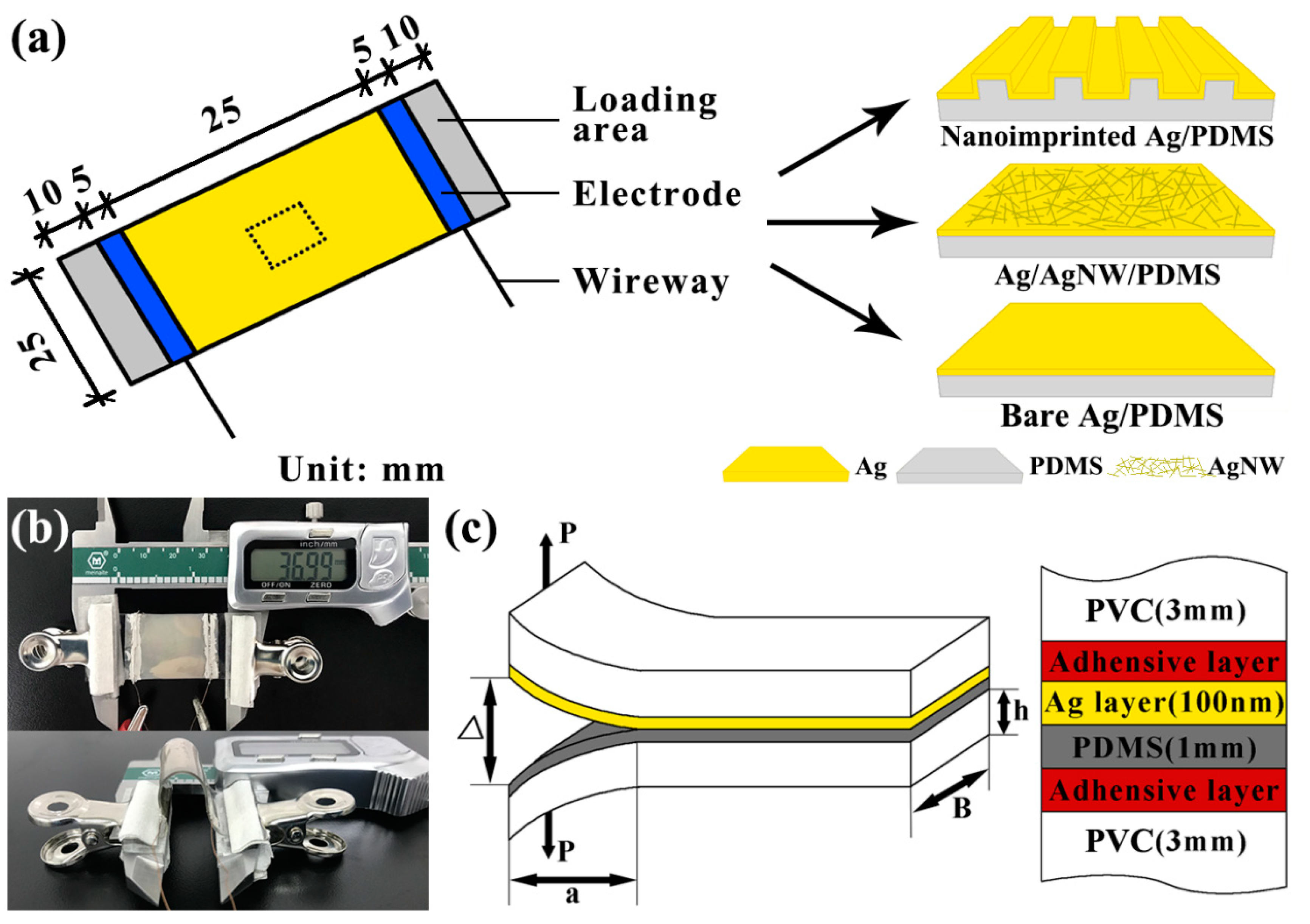
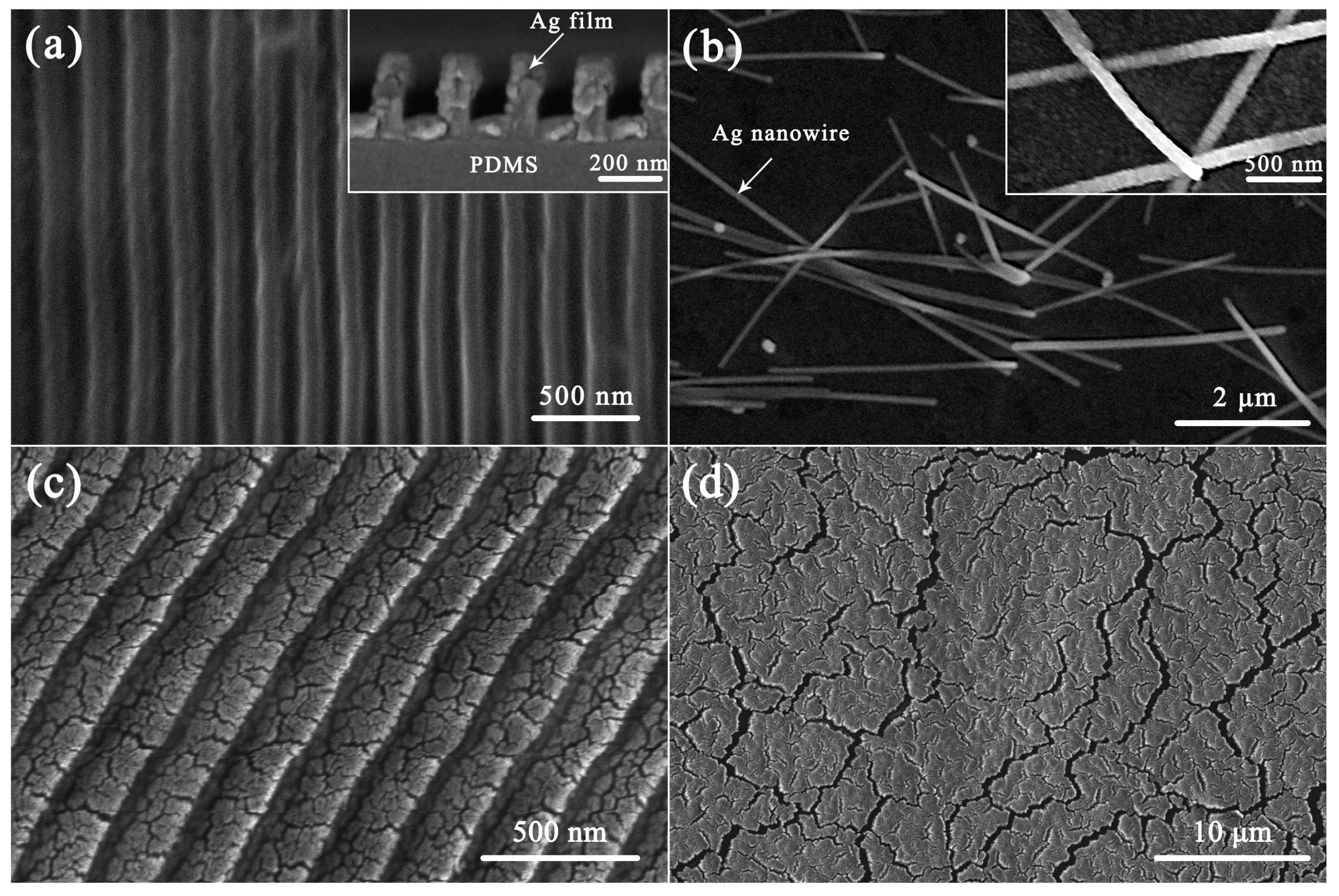
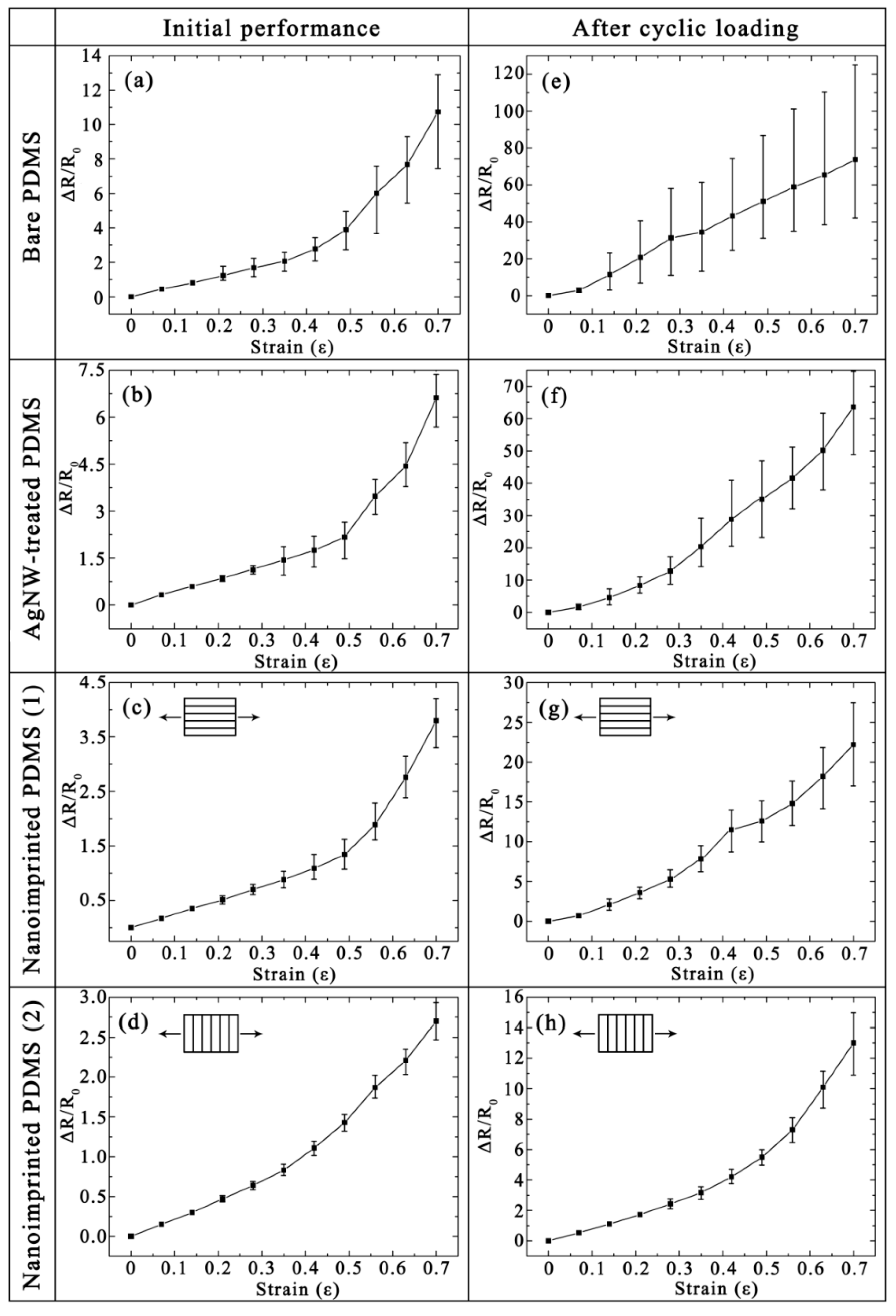
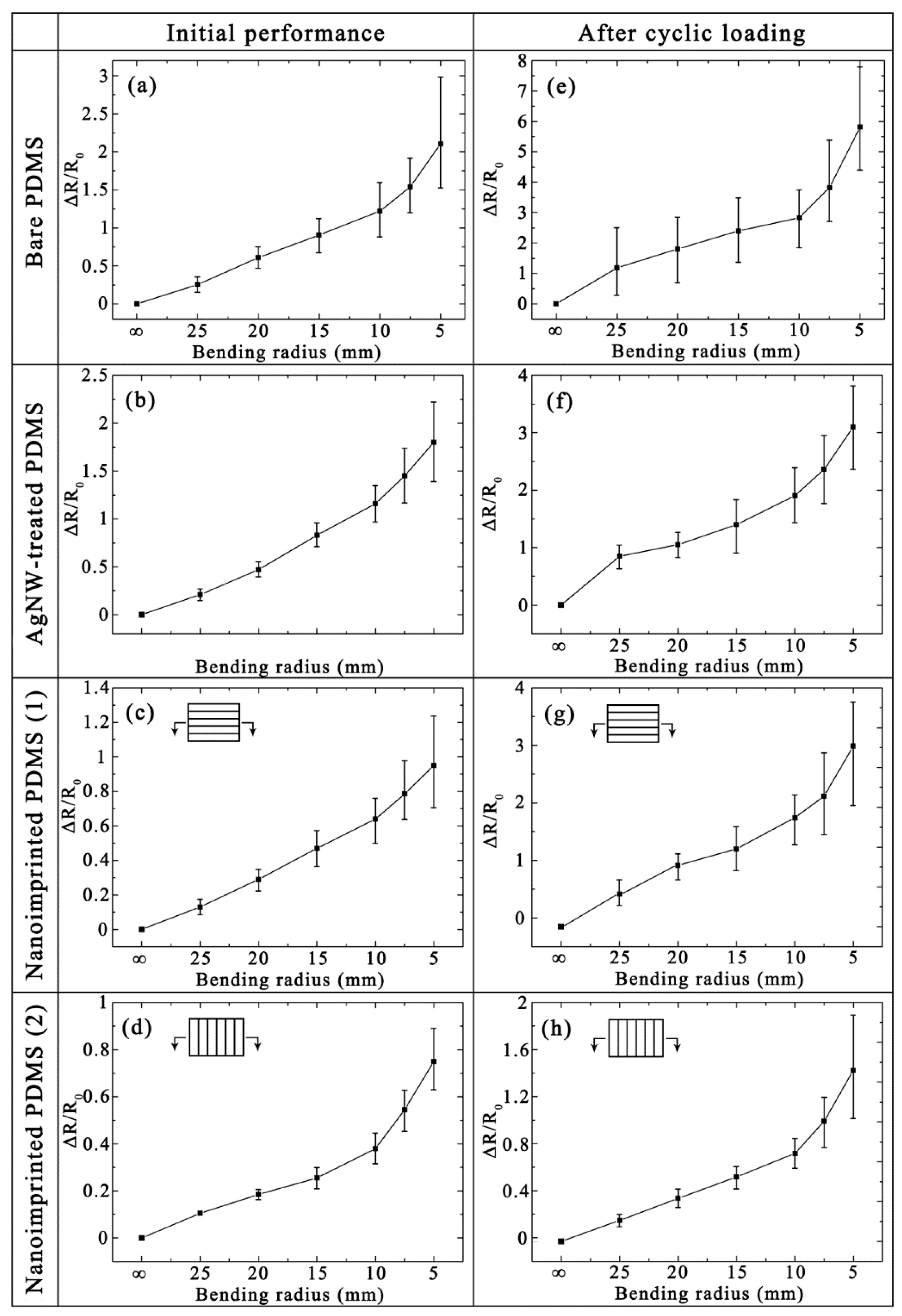
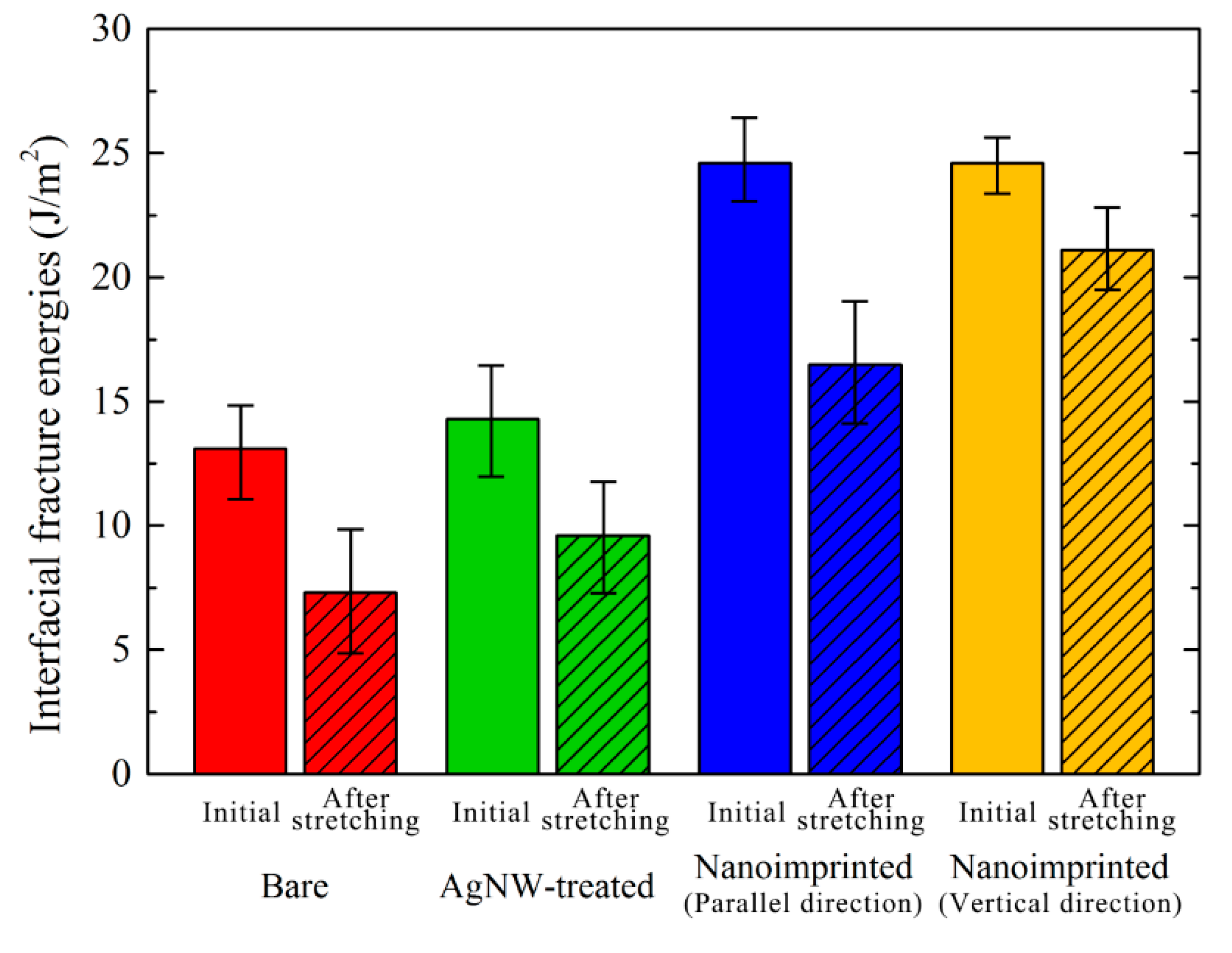
© 2019 by the authors. Licensee MDPI, Basel, Switzerland. This article is an open access article distributed under the terms and conditions of the Creative Commons Attribution (CC BY) license (http://creativecommons.org/licenses/by/4.0/).
Share and Cite
Zheng, X.; Wang, Q.; Luan, J.; Li, Y.; Wang, N. Patterned Metal/Polymer Composite Film with Good Mechanical Stability and Repeatability for Flexible Electronic Devices Using Nanoimprint Technology. Micromachines 2019, 10, 651. https://doi.org/10.3390/mi10100651
Zheng X, Wang Q, Luan J, Li Y, Wang N. Patterned Metal/Polymer Composite Film with Good Mechanical Stability and Repeatability for Flexible Electronic Devices Using Nanoimprint Technology. Micromachines. 2019; 10(10):651. https://doi.org/10.3390/mi10100651
Chicago/Turabian StyleZheng, Xu, Qing Wang, Jinjin Luan, Yao Li, and Ning Wang. 2019. "Patterned Metal/Polymer Composite Film with Good Mechanical Stability and Repeatability for Flexible Electronic Devices Using Nanoimprint Technology" Micromachines 10, no. 10: 651. https://doi.org/10.3390/mi10100651





